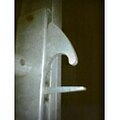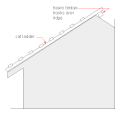Ladder: Difference between revisions
Jackehammond (talk | contribs) →External links: deleted commercial spam -- Jack |
|||
| Line 9: | Line 9: | ||
==Variations== |
==Variations== |
||
Rigid ladders are available in many forms, such as: |
Rigid ladders are available in many forms, such as: |
||
*[[Bridge ladder]], a ladder |
*[[Bridge ladder]], a ladder tyutyutyutyutyu gftyujgty6ujlaid horizontally to act as a passage between two points separated by a drop. |
||
*Cat ladder (US chicken ladder), a lightweight ladder frame used on steep roofs to prevent workers from sliding |
*Cat ladder (US chicken ladder), a lightweight ladder frame used on steep roofs to prevent workers from sliding |
||
*[[Extension ladder]] or "Telescopic ladder", a fixed ladder divided into two or more lengths for more convenient storage; the lengths can be slid together for storage or slid apart to maximize the length of the ladder; a pulley system may be fitted so that the ladder can be easily extended by an operator on the ground then locked in place using the [[Dog clutch|dogs]] and [[pawl]]s |
*[[Extension ladder]] or "Telescopic ladder", a fixed ladder divided into two or more lengths for more convenient storage; the lengths can be slid together for storage or slid apart to maximize the length of the ladder; a pulley system may be fitted so that the ladder can be easily extended by an operator on the ground then locked in place using the [[Dog clutch|dogs]] and [[pawl]]s |
||
Revision as of 12:43, 4 October 2011
This article needs additional citations for verification. (May 2007) |


A ladder is a vertical or inclined set of rungs or steps. There are two types: rigid ladders that can be leaned against a vertical surface such as a wall, and rope ladders that are hung from the top. The vertical members of a rigid ladder are called stringers (US) or stiles (UK). Rigid ladders are usually portable, but some types are permanently fixed to buildings. They are commonly made of metal, wood, or fibreglass, but they have been known to be made of tough plastic.
Variations
Rigid ladders are available in many forms, such as:
- Bridge ladder, a ladder tyutyutyutyutyu gftyujgty6ujlaid horizontally to act as a passage between two points separated by a drop.
- Cat ladder (US chicken ladder), a lightweight ladder frame used on steep roofs to prevent workers from sliding
- Extension ladder or "Telescopic ladder", a fixed ladder divided into two or more lengths for more convenient storage; the lengths can be slid together for storage or slid apart to maximize the length of the ladder; a pulley system may be fitted so that the ladder can be easily extended by an operator on the ground then locked in place using the dogs and pawls
- Fixed ladder, two side members joined by several rungs; affixed to structure with no moving parts
- Folding ladder, a ladder in the step ladder style with one or more (usually no more than three) one-way hinges. Ideal for use on uneven ground (i.e. stairs), as a trestle or when fully extended a Fixed ladder. Some variations feature a central one-way hinge with extensible locking legs
- Hook ladder or pompier ladder, a rigid ladder with a hook at the top to grip a windowsill; used by firefighters
- Orchard ladder, a three legged step ladder with third leg made so that it can be inserted between tree branches for fruit picking
- Platform steps, a step ladder with a small horizontal platform at the top
- Roof ladder, a rigid ladder with large hook at the top to grip the ridge of a pitched roof
- Sectional ladder, also known as a builder's ladder, is a ladder that has sections that come apart and are interchangeable so that any number of sections can be connected together.
- Step ladder, hinged in the middle to form an inverted V, with stays to keep the two halves at a fixed angle
- Telescoping ladder, commonly used to refer to a hybrid between a step ladder and an extension ladder with 360 degree hinges. Has three parts and can be taken apart to form two step ladders. The Little Giant is an example of a telescoping ladder.
- Turntable ladder, an extension ladder fitted to rotating platform on top of a fire truck
- Vertically rising ladder, a ladder designed to climb high points and facilitate suspending there.
Rigid ladders were originally made of wood,but in the 20th century tubular aluminium became more common because of its lighter weight. Ladders with fibreglass stiles are used for working on or near overhead electrical wires, because fibreglass is an electrical insulator.[1]
Safety
For safety, a rigid ladder should be leaned at an angle of about fifteen degrees to the vertical. In other words, the distance from the foot of the ladder to the wall should be about one quarter of the height of the top of the ladder. At steeper angles, the ladder is at risk of toppling backwards when the climber leans away from it. At shallower angles, the ladder may lose its grip on the ground. Ladder stabilizers are available that increase the ladder's grip on the ground. One of the first ladder stablilizers or ladder feet was offered in 1936 and today is standard equipment on most large ladders. [2]
A ladder standoff, or stay, is a device fitted to the top of a ladder to hold it away from the wall. This enables the ladder to clear overhanging obstacles, such as the eaves of a roof, and increases the safe working height for a given length of ladder.
Uses
- Rope ladders are used where storage space is extremely limited, weight must be kept to a minimum, or in instances where the object to be climbed is too curved to use a rigid ladder. They may have rigid or flexible rungs. Climbing a rope ladder requires more skill than climbing a rigid ladder, because the ladder tends to swing like a pendulum. Steel and aluminium rope ladders are sometimes used in vertical caving.
- Dissipative ladders are portable ladders built to ESD (Electrostatic Discharge) standard. Electrostatic Discharge is a natural occurrence in which electricity is passed through our body, or other conductor, and discharges onto some object. For example, the shock we sometimes feel when we touch a doorknob is an ESD. This natural occurrence is becoming a very hot topic in the field of electronics assembly due to the costly damage ESDs can cause to sensitive electronic equipment. Dissipative ladders are ladders with controlled electrical resistance: the resistance slows the transfer of charge from one point to another, offering increased protection during ESD events: ≥105 and < 1012 Ω / square.
- Pool ladders. A ladder is also used on the side of a boat, to climb into it from the water, and in a swimming pool. Swimming pool ladders are usually made from plastic steps with special grip and metal bars on the sides to support the steps and as handrails for the user.
- Assault ladders. These are designed to be used by units which may need to board or assault vessels or buildings. They can be used when a full sized ladder is not required or when working in confined spaces. Suited for covert operations such as sniper placement, and vessel boardings. It was developed and designed for tubular assaults including buses and trains and for first story breaching. Its extra wide design gives the user greater stability, but still can fold away to be stored. It is available in standard aluminium or non-reflective black finish in 6 and 8 feet lengths.
Historical usage
Ladders are ancient tools and technology. A ladder is depicted in a Mesolithic rock painting that is at least 10,000 years old, depicted in the Spider Caves in Valencia, Spain.[3] references the rock painting which shows two naked humans carrying baskets or bags that are employing a long wobbly ladder, which appears to be made out of some kind of grass, to reach a wild honeybee nest to harvest honey. Modern ladders are believed to have been conceived by Hebrews and Egyptians.
Superstition
It is commonly said that walking under a ladder is bad luck. This is believed [who?] to have started in the Medieval times. It was believed that a leaning ladder resembled the gallows, so to walk under it would ensure a death by hanging. [citation needed] Another belief is that the leaning ladder resembles a triangle, or the Holy Trinity. Thus, by walking through it, one would be violating God. [citation needed] Yet another explanation comes from ancient Egyptians who believed that the triangle was a magical shape, because that was the shape of the pyramids. As such walking under it would break the shape. [citation needed]
See also
-
Photo of a dog and pawl on an extension ladder.
-
Sketch of Cat Ladder (UK terminology) an aid when working on steep roofs.
-
Sketch of double extension ladder
References
- ^ "Preventing Worker Deaths and Injuries from Contacting Overhead Power Lines with Metal Ladders". National Institute of Occupational Safety and Health. Workplace Solutions, Publication No. 2007-155, September 2007.
- ^ "Metal Rubber Feet for Ladder Prevents Slipping" Popular Science, April 1936 article at bottom left of pg 499
- ^ Wilson, Bee (2004). The Hive: The Story Of The Honeybee. London, Great Britain: John Murray (Publishers). ISBN 0 7195 6598 7
External links
- Ladder Safety including Ladder Types (Type I, Type II, Type III)
- Ladder Usage Safety and handling ladders
- Ladder safety manuals
- OSHA Ladder guidelines including OSHA approved rung spacing requirements, etc.



